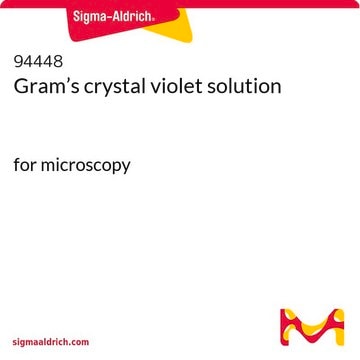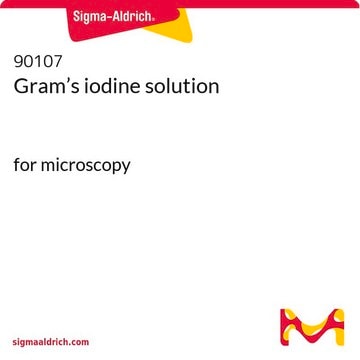Products with a high water content away from "the generally known reaction partners of water." This caution is due to water's potential to react violently with numerous substances, resulting in the development of gases and the ignition of released Hydrogen, posing a risk of explosion.
Additionally, various substances or mixtures can explode upon the addition of a drop of water, with details of these reactions provided in the safety data sheets of the specific reaction partners. Substance groups that react violently with water include Alkaline earth metals, Alkaline metals, Aluminum alkalines, Metallic or Nonmetallic hydrides, Metallic or Nonmetallic oxides, Acid anhydrides, and Acid chlorides.
V5265
Crystal Violet Solution
1%, aqueous solution
Sélectionner une taille de conditionnement
Sélectionner une taille de conditionnement
About This Item
Produits recommandés
Forme
aqueous solution
Niveau de qualité
Concentration
1%
Technique(s)
microbe id | staining: suitable
Couleur
deep violet, purple
Amax
0.36-0.44 at 589-594 nm
Application(s)
diagnostic assay manufacturing
hematology
histology
Température de stockage
room temp
Chaîne SMILES
[Cl-].CN(C)c1ccc(cc1)\C(c2ccc(cc2)N(C)C)=C3/C=C\C(C=C3)=[N+](/C)C
InChI
1S/C25H30N3.ClH/c1-26(2)22-13-7-19(8-14-22)25(20-9-15-23(16-10-20)27(3)4)21-11-17-24(18-12-21)28(5)6;/h7-18H,1-6H3;1H/q+1;/p-1
Clé InChI
ZXJXZNDDNMQXFV-UHFFFAOYSA-M
Vous recherchez des produits similaires ? Visite Guide de comparaison des produits
Description générale
It stains the fatty portions of sebaceous sweat a deep purple color. Crystal violet can also be used to enhance bloody fingerprints. This dye is harmful if inhaled, swallowed or absorbed through skin, contact may cause cancer, severe eye irritation in human beings.[2]
Application
- Crystal violet is commonly used in Gram staining for the classification of bacteria.[3]
- It has also been used to detect bacterial adherence to biomedical polymers and to stain DNA in mammalian tissues in Giemsa staining.
- It has been successfully used to develop a counterion-staining method to detect DNA in agarose gel electrophoresis.[4]
- Its antimicrobial properties have facilitated its use in the treatment of oral candidiasis, skin infections, and methicillin-resistant Staphylococcus aureus.[1]
- It has been used as a stain in cell proliferation assays, migration assays, and Boyden chamber assay.[5][6][7]
Actions biochimiques/physiologiques
Principe
Mention d'avertissement
Warning
Mentions de danger
Conseils de prudence
Classification des risques
Aquatic Chronic 3 - Carc. 2 - Eye Irrit. 2
Code de la classe de stockage
12 - Non Combustible Liquids
Classe de danger pour l'eau (WGK)
WGK 2
Point d'éclair (°F)
Not applicable
Point d'éclair (°C)
Not applicable
Faites votre choix parmi les versions les plus récentes :
Certificats d'analyse (COA)
Vous ne trouvez pas la bonne version ?
Si vous avez besoin d'une version particulière, vous pouvez rechercher un certificat spécifique par le numéro de lot.
Déjà en possession de ce produit ?
Retrouvez la documentation relative aux produits que vous avez récemment achetés dans la Bibliothèque de documents.
Les clients ont également consulté
Contenu apparenté
Un aperçu de la science et de la pratique de la bactériologie en diagnostic clinique. Apprenez-en davantage sur l'application des colorants standards et spéciaux pour l'analyse au microscope.
An overview of the science and practice of bacteriology in clinical diagnostics. Learn more about the application of standard and special stains for microscopic analysis.
-
What does "generally known reaction partners of water" refer to in section 10.3 of the V5265 SDS? Additionally, in the SDS for a similar product, C6158, states that violent reactions are possible with strong oxidizing agents, strong acids, and oxidizing agents.
1 answer-
Helpful?
-
-
What solvent is the crystal violet diluted in? Can it be used for staining cells for colony formation assay directly or will fixation with methanol/ethanol be needed prior to the staining?
1 answer-
This product is a 1% solution of Crystal Violet in water. For colony formation assays, it is more common to dissolve the crystal violet in a methanol-based solution. However, it is possible to fix the cells in methanol for 10-15 minutes prior to staining cells with an aqueous Crystal Violet Solution. Some sources recommend substituting absolute ethanol for methanol. Following fixation, the cells can be stained with aqueous Crystal Violet solution.
Helpful?
-
-
What is the shelf life / expiry of this solution?
1 answer-
This product is not assigned an expiration date or recommended retest date. Products with no expiration date or recommended retest date should be routinely inspected by customers to ensure they perform as expected. These products are also subject to a one year warranty from the date of shipment. For more information you may access the "Product Dating Information" document under "ADDITIONAL USEFUL DOCUMENTS ABOUT OUR PRODUCTS" at the bottom of the Quality Services page with this link: https://www.sigmaaldrich.com/life-science/quality-and-regulatory-management/quality-services.
Helpful?
-
Active Filters
Notre équipe de scientifiques dispose d'une expérience dans tous les secteurs de la recherche, notamment en sciences de la vie, science des matériaux, synthèse chimique, chromatographie, analyse et dans de nombreux autres domaines..
Contacter notre Service technique






